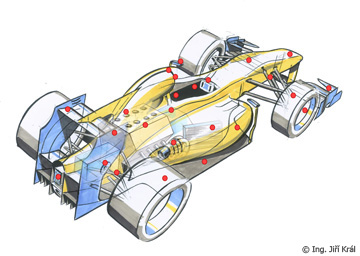┼Ākoda returns to Le Mans
P.Havl├Ł─Źek tex i foto | 5.6.06 | P. Havl├Ł─Źek
On 5 June 2006 four musketeers with a mobile garage and the ┼Ākoda Sport under a tarpaulin set off from Kutna Hora for the French town of Le Mans. I do not know who felt like Athos, Porthos, Aramis or DŌĆÖArtagnan, but the thrill they must have felt from the days to come undoubtedly was similar to the one felt by those famous four DumasŌĆś heroes galloping to England for the QueenŌĆÖs necklace.
┼Ākoda 1101 Sport, transported on a trailer, was
built for the Grand Prix of Brno 1949 in a short time of about seven weeks, it
is assembled mainly of regular parts of ┼Ākoda 1101 Tudor. It is powered by a four cylinder, fluid cooled OHV engine, derived from the stock products, with
bore 68 mm, stroke 75 mm and capacity of 1089 ccm. There is the battery
ignition, dynamo and PAL starter. The valves were made bigger, the air inlet
and exhaust were adjusted and the compression ratio was increased to 8.6:1,
which put the power up to 50 hp (37 kW) at 5200 rpm. The radiator was lowered
and adjusted to fit into the bodywork. The gearbox remained standard, four
gears with different gear settings. Also the steering and brakes remained
standard, similarly to both axles, where only the springs stiffness was
adjusted. There is a wishbone front axle, the lower arms being transversal
semielliptical spring leaf. The rear axle features two shortened pendulum
half-axles, also sprung by a spring leaf. The backbone fork-like car frame is
also a stock production, but with some weight reduction and adjustments. The
panels are made of aluminium sheet. The machine weighs 715 kg and it maximum
speed tops at 145 kph. In 1949 another car with a supercharger was
manufactured, however that one probably does not already exist.
During
its premiere in Brno
the not supercharged version came 1st in the 1100 ccm category, the
supercharged one came second. The cars regularly won in their categories in the
CSSR also in the years to come.
The uncharged car with two drivers Vaclav Bobek and Jaroslav Netusil participated in the 24 Hours Le Mans in 1950. Although it started well it had to retire after 14 hours with an engine trouble. The problem was in the ruptured safety pin of the piston pin, probably a material defect. 56 years later JUDr. Jan Egidy, the owner of the car, together with two drivers Miroslav Krejsa and Miroslav Svoboda and a mechanic Milan Pekny, went to Le Mans once again to take part in the veteran race Le Mans Classic, to make his dream come true, show the beautiful body of the sports car and improve results reached by the factory team in 1950.
The Le Mans Classic was first organized in 2002 to celebrate the long history of the 24 Hours Le Mans which started in 1923. It is held with a two-year period so this year it was the 3rd time of the amazing show. The race is open exclusively to cars that already raced there between the years 1923 and 1979. There are six categories according to the age. The first involves cars from 1923 to the last pre-war year 1939, the second covers the post-war vehicles from 1949 to 1956, the third from 1957 to 1961, the fourth from 1962 to 1965, the fifth from 1966 to 1971 and the last from 1972 to 1979. There are over 60 cars in each category, so you can see the total of 400 beautiful cars that may otherwise be seen only in the most famous world museums. Each category races three stints 45 minutes long and therefore you can see one amazing race after another for the full 24 hours.
The viewers have the chance to return to the unbelievable times before the Second World War, when the Bentley cars were winning in Le Mans, or Tazio Nuvolari with Alfa Romeo, including the original start when the drivers run across the road to their cars. Or they can experience again the famous movie Le Mans with Steve McQueen and the duel between Porsche and Ferrari. It is like a journey back in a time machine to experience the amazing history of the Le Mans race in one weekend.
Jan Egidy's team and the ┼Ākoda Sport successfully overcame all financial and technical problems and finished at the 47th place, which means an excellent 15th place after the output ratio has been applied from the total of 69 cars in the second category from 1949 to 1956.
This result seems even better considering the fact that the race did not go without problems and that the ┼Ākoda car was the second oldest and the second weakest engine (in the category 2). The team deserves thanks for the perseverance that they proved in the race. After the first race it seemed that the Le Mans circuit is cursed for ┼Ākoda. The insulation under the cylinder head burned after 5 laps, a traditional problem of the engine, and the car had to be towed to the finish. The team managed to repair the trouble and it worked perfectly in the remaining two races.
In conclusion, let us wish, together with the 60 thousand this year's visitors, that the ┼Ākoda would appear in Le Mans some time in future again and that there would be more interest in the action from the Czech fans, media and sponsors.
Petr Havlicek
Links: official timing and results www.lemansclassic.com
Czech Le Mans Classic homepage www.lemans.cz
Czech ┼Ākoda Sport homepage www.lemansclassic.wz.cz




